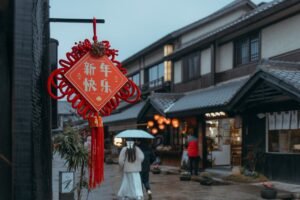Table of Contents
ToggleIntroduction
Chunjie (春节, Chūn Jié), often referred to as the Spring Festival or simply Chinese New Year, is undoubtedly the most significant and widely celebrated festival in China. It marks the beginning of the lunar new year, which usually falls between late January and mid-February in the Gregorian calendar. Spanning about 15 days, Chinese New Year culminates in the Lantern Festival (元宵节, Yuánxiāo Jié). For countless Chinese people worldwide, this holiday is the apex of the year—a time for families to reunite, to pay respects to tradition, and to usher in good fortune.
For those who have never experienced it, witnessing or participating in the Spring Festival can be mesmerizing: bustling street markets overflow with special goods, people adorn their homes with red and gold decorations, and family gatherings revolve around a lavish array of symbolic dishes. It’s a time filled with fireworks, lion dances, and expressions of hope for the year ahead.
In this article, we will explore the essence of Chunjie (春节, Chūn Jié) by examining the myths behind it, the cultural practices that define it, and its modern-day significance. Finally, we’ll touch upon how you can learn more about the Chinese language and culture—right here in Oslo—through the LC Chinese School’s flexible classes.
Historical Background
The Legend of Nián (年)
One of the most commonly told stories about the origins of the Spring Festival is the tale of Nián (年), a fierce beast said to dwell in the sea or deep in the mountains. According to legend, Nián emerged at the turn of the lunar new year to wreak havoc on villages. People discovered Nián’s weaknesses: loud noises, bright lights, and the color red. By lighting torches, banging drums, and hanging red paper decorations, villagers could scare Nián away.
From this myth comes the custom of setting off fireworks, using loud firecrackers (爆竹, bàozhú), and decorating everything in red during the New Year celebrations. These elements act as guardians against misfortune and usher in a sense of renewal.
The Lunar Calendar
Chunjie (春节, Chūn Jié) aligns with the beginning of the Chinese lunar year, meaning the timing is determined by moon phases. Each month starts on a new moon, and a full lunar year can have 12 or 13 months. Hence, the date of Chinese New Year shifts each year relative to the solar-based Gregorian calendar.
Traditional Preparations
The “Big Clean”
In the days leading up to Chunjie (春节), families thoroughly clean their homes—a practice symbolizing the sweeping away of ill-fortune and clearing out the old to make way for new blessings. Worn-out items may be discarded, and fresh textiles, pillows, and red-and-gold decorations take their place. This housecleaning ritual is deeply rooted in the belief that good fortune thrives in a clean and welcoming environment.
Decorations
Red is the dominant color during Chinese New Year, representing happiness and prosperity. People hang red paper cuttings (剪纸, jiǎnzhǐ) featuring the character Fú (福), meaning “blessing” or “good fortune.” They also post pairs of poetic couplets known as duìlián (对联) around door frames to convey wishes of success and good luck. Additionally, red lanterns (灯笼, dēnglóng) and banners adorn streets and homes.
Shopping and Gifts
In the week or so prior to the New Year, markets are bustling with activity as families stock up on essentials and festive foods. Children and young adults often receive hóngbāo (红包)—red envelopes filled with money—from elders. This exchange symbolizes the transfer of blessings and prosperity to the younger generation.
The Festival Period
Although Spring Festival typically spans 15 days, certain days stand out:
- New Year’s Eve (除夕, Chúxī)
The most significant night of the celebration, New Year’s Eve brings the entire family together for a sumptuous reunion dinner (年夜饭, niányèfàn). This meal is seen as the highlight of the festival and is sometimes followed by watching the annual New Year Gala on CCTV (中国中央电视台, Zhōngguó Zhōngyāng Diànshìtái). At midnight, firecrackers and fireworks light up the sky, symbolically warding off misfortune and greeting the new year. - New Year’s Day (初一, chūyī)
Traditionally, this day is set aside for visiting older relatives or grandparents. Well-wishes for the new year are exchanged. Common greetings include Gōngxǐ fācái (恭喜发财), which literally means “congratulations, get rich!” - Days Leading Up to the Lantern Festival
Over the next two weeks, each day has specific customs. People might visit friends, prepare special meals, or continue family traditions. In northern China, eating jiǎozi (饺子, dumplings) is popular, while in the south, tāngyuán (汤圆, glutinous rice balls) are favored. - Lantern Festival (元宵节, Yuánxiāo Jié)
The 15th day closes out the Spring Festival with a dazzling lantern display. Streets are lit by ornate lanterns of all shapes and sizes, riddles are sometimes written on them, and solving these riddles is a festive pastime. People eat sweet sticky rice balls called yuánxiāo (元宵) or tāngyuán (汤圆). The lanterns symbolize guidance and togetherness.
Culinary Traditions
Food is central to Chinese culture, and it becomes even more significant during Chunjie (春节). Different regions have their own specialties, but some dishes carry symbolic meanings shared nationwide:
- Jiǎozi (饺子, dumplings): In northern China, dumplings are eaten at midnight on New Year’s Eve. Their shape resembles ancient Chinese silver or gold ingots, believed to bring wealth.
- Yú (鱼, fish): The word for fish (鱼, yú) sounds like the word for “surplus” or “abundance.” Serving a whole fish—and leaving part of it uneaten—symbolizes the hope for prosperity that continues through the new year.
- Niángāo (年糕, glutinous rice cake): The name niángāo (年糕) sounds like “year high,” suggesting rising prosperity year after year.
- Chūnjuǎn (春卷, spring rolls): These golden-brown rolls look like little bars of gold, making them a favorite for attracting good fortune.
Symbols and Rituals
Firecrackers and Fireworks
Historically, the explosions of firecrackers (爆竹, bàozhú) were crucial to scaring off Nián (年). Although firework usage has been restricted in some cities due to safety and pollution concerns, rural areas often maintain this vibrant tradition, lighting up the night sky and creating a festive cacophony.
Red Color and Calligraphy
Red is the color of luck, happiness, and energy. Handwritten calligraphy on red paper—featuring auspicious phrases and characters—remains one of the most recognizable elements of the Spring Festival atmosphere.
Family Reunions
Family unity is arguably the most important aspect of the festival. The travel period leading up to Chunjie (春节) is sometimes called the world’s largest human migration, as millions of people head home to reunite with parents, siblings, and extended family.
A Modern Twist on an Ancient Tradition
Globalization and New Habits
With China’s growing international presence, Spring Festival is increasingly celebrated worldwide. In cities like London, New York, Sydney, and even Oslo, festive events—lion dances, parades, and cultural shows—draw crowds of both Chinese expatriates and curious locals. This global embrace reflects China’s cultural reach.
Commercialization
Like many other major holidays, commercialization has found its way into Chunjie (春节). Shopping malls host sales and themed promotions, while many people exchange virtual “red envelopes” via messaging apps like WeChat (微信, Wēixìn). Despite this modern layer, traditional rituals—like family feasts and ancestral respects—still hold strong.
Experiencing Chunjie in Oslo and Beyond
Even though Norway’s Chinese community is smaller compared to some other parts of the world, Oslo hosts a few events that capture the spirit of Chinese New Year. Chinese associations and restaurants sometimes organize festive gatherings, featuring lion dance performances, cultural presentations, and of course, delicious Chinese banquets. For Norwegians, attending these events can be a unique way to experience a touch of Far Eastern celebration right at home.
Learn Chinese in Oslo
If you find yourself enthralled by the warmth, color, and cultural depth of Chunjie (春节), you might want to explore the Chinese language. Learning Mandarin (普通话, Pǔtōnghuà) is an excellent way to gain deeper insight into not only the mechanics of the festival but also the values and stories that underpin it. Fortunately, you don’t have to hop on a plane to Beijing or Shanghai to study Chinese. Right here in Oslo, the LC Chinese School provides flexible classes designed for everyone from absolute beginners to advanced learners. Through structured lessons, you can learn:
- Pīnyīn (拼音): The Romanization system for Mandarin pronunciation.
- Basic Vocabulary and Grammar: Essential for everyday communication.
- Chinese Characters (汉字, Hànzì): A key to understanding written texts, traditional symbolism, and cultural references.
- Cultural Context: Delve into holiday customs, idiomatic expressions, and historical background.
By enrolling in a course, you can progress steadily and build a lasting connection with China’s language and cultural fabric. Imagine being able to offer a hearty “Xīnnián kuàilè (新年快乐)!” to Chinese friends or reading the auspicious characters on red banners during the Spring Festival with understanding and pride.
Practical Tips for Celebrating Chunjie Yourself
- Cook Dumplings or Spring Rolls
Head to an Asian grocery store to pick up ingredients. Gather friends or family to make dumplings or spring rolls, turning the culinary experience into a communal, fun-filled event. - Decorate with Red
Hang red lanterns (灯笼, dēnglóng), paper cuttings (剪纸, jiǎnzhǐ), or calligraphic banners around your home. These instantly create a festive ambiance. - Watch Chinese New Year Films or Galas
Streaming services often feature Chinese New Year specials, movies, or TV episodes set around the holiday. Watching these can help you better understand the cultural importance of Chunjie (春节). - Learn a New Year’s Greeting
A simple phrase like Xīnnián kuàilè (新年快乐)—meaning “Happy New Year!”—or Gōngxǐ fācái (恭喜发财)—“May you be prosperous!”—can go a long way in showing appreciation for Chinese traditions. - Dine Out at a Chinese Restaurant
Many Chinese restaurants curate a special menu for Chunjie (春节), featuring dishes that signify good luck. You might even catch a lion dance performance or other live entertainment.
Cultural Exchange and Understanding
Chunjie (春节, Chūn Jié) is not merely the celebration of a new calendar year; it underscores important values in Chinese society: strong family ties, respect for tradition, and a hopeful perspective on life. For Chinese families living abroad, celebrating Spring Festival is a way to retain a connection to their heritage. For non-Chinese observers, it offers an immersive introduction to one of the world’s oldest and richest cultures.
Final Reflections
The Spring Festival, or Chunjie (春节, Chūn Jié), represents an annual moment of renewal. Steeped in legends like the story of Nián (年) and enriched by countless regional customs, it continues to thrive in a swiftly modernizing China. Despite globalization and commercialization, its core traditions—family reunion, symbolic foods, and the color red—remain potent reminders of China’s cultural essence.
For those eager to explore this vibrant holiday more fully, studying the Chinese language is a rewarding avenue. And if you’re based in Norway, LC Chinese School in Oslo provides flexible lessons to help you unlock the door to Mandarin and deepen your cultural insight. With greater language skills, you can truly appreciate the red lanterns, the taste of dumplings, the thunder of firecrackers, and the sentiments behind “Xīnnián kuàilè (新年快乐)!”
Ultimately, Chunjie (春节) illustrates how a single festival can encompass layers of ancient lore, communal bonding, and modern celebrations—all while carrying forward timeless values of hope, joy, and shared prosperity. Whether you try cooking dumplings in your own kitchen or visit a bustling New Year event in the heart of a Chinese metropolis, you’ll witness how Chunjie (春节) captures the human desire to start fresh, remember old bonds, and look toward the future with optimism. May your own Spring Festival experience be filled with warmth, laughter, and perhaps even a phrase or two of Mandarin to share the joy. Xīnnián kuàilè (新年快乐)!








